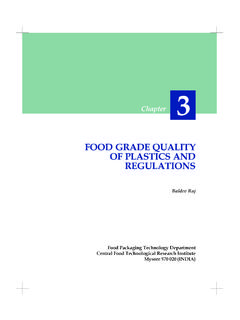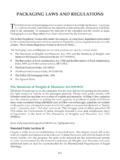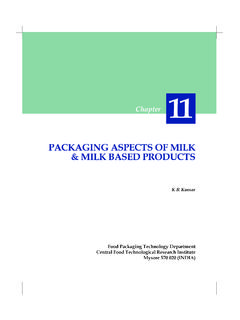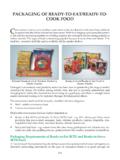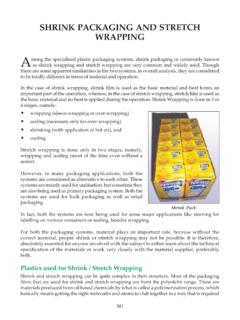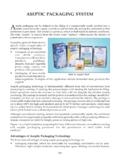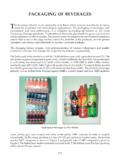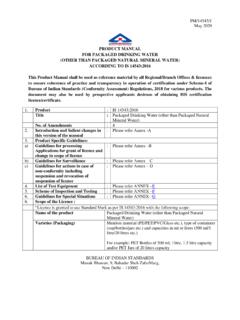Transcription of PLASTICS FOR FOOD PACKAGING: NATIONAL AND …
1 373 PLASTICS FOR food packaging : NATIONAL AND INTERNATIONALSTANDARDSB efore proceeding to acquaint ourselves with application of standards in the field of foodpackaging, it would be useful for us to recapitulate the definitions of the two words,namely standards and standardisation .A standard is a result of a particular standardisation effect, approved by the recognisedauthority. It may take the form of a document containing a set of conditions to be fulfilled, afundamental unit or physical constituent or an object for physical comparison.
2 Standardisation is the process of formulating and applying the rules for an orderly approachto a specific activity - for the benefit of all - with the co-operation of all concerned and inparticular for the promotion of optimum overall economy, taking due account of functionalconditions and safety requirements. Standardisation is based on the consolidated results ofscience, technology and experience. It determines not only the basis for the present but alsofor future development and it should keep pace with development of packaging , as science and technology, has witnessed a phenomenal growthin the recent years.
3 Traditional materials like metal, wood and jute are being replaced by lightweight PLASTICS , fibreboard boxes and containers made of laminated and coated materials. Inorder to successfully and safely market food products as well as enter the export market, thepackage must conform to the prevailing specifications, trends and preferences of the the context of all these factors, application of standards and standardisation for foodpackaging needs, can play a vital role in putting the food packaging industry on a soundfooting for developing domestic and international are several aspects of standards.
4 These may include: Specifications of products and materials Codes of practices Standard test methods Standard terminologies, symbols, colour schemes, nomenclature, notations etc. Standard sampling procedures Inspection methods Criteria for conformityThere are different levels of standards, which may be listed as: An Individual Standard A Company Standard374 An Association Standard A NATIONAL Standard An International StandardThe level is determined by the specific interests involved in creating and using the standard inday-to-day are various benefits to standardisation.
5 To mention a few briefly; the following arelisted: To the Producer Rationalisation of manufacturing processes, improved controlof processes/materials, high rate of production, reduction ofinventories, ultimate increase in sales and hence profits. To the Consumer Assurance of quality of food and services purchased, better valuefor money spent. To the Trade Minimisation of delays, workable basis for acceptance or rejectionof goods, opening of larger markets, reduction in cost of handlingtransactions.
6 To the Technologist Increased knowledge of properties, possibilities of application ofmaterials, accepted methods of tests and procedures, guidancefor formulation of R & D Standards on food PackagingThe technical committees of the Bureau of Indian Standards (BIS) formulate the NationalStandards. The primary objective of this organisation is to prepare and promulgate and use of the right packaging material, and the role it plays in preservation andprotection of perishable and non-perishable foodstuffs has become very important in today sscenario.
7 In the transportation and distribution of these products, safe handling andeconomic factors also play a vital role. In order to provide safe and hygienic food product tothe consumers, handling of the raw materials and finished products and the selection anduse of a safe and clean packaging material are of utmost importance. For perishables suchas meat, fish, fruits and vegetables, which are stored and transported under refrigeration orin frozen conditions, proper maintenance of a cool or cold chain is BIS has brought out an Indian Standard on Code of Practice IS 10106 (Part 1 / sec 1):1990, where part 1 deals with Product packaging and section 1 with Foodstuffs andPerishables.
8 This code has laid down guidelines for packaging of various foodstuffs insuch a way so as to protect them from returnable containers it has further explained the procedures to keep the containersclean for re-use. packaging of foodstuffs and perishables commonly used by the masses are375covered, and are classified into the following categories in their decreasing order ofperishability: Milk and milk products Fruits and vegetables Meat, fish and poultry Bakery and confectionery products Protein rich food Edible starch and starch based products Oils and fats Foodgrains and food grain products Sugar and honey Stimulant food Alcoholic drinks and carbonated beverages Spices and condimentsThe code has recommended various types of packaging materials for the above product groups,which are listed in Appendix Table 1 (at the end of the article).
9 This standard has other parts and sections, which are also to be followed along with the part 1and sec 1 IS : 10106 (Part 2, sec 6) 1990 packaging Code : packaging materials : Flexible laminates, and IS : 10106 (Part 4, sec 3) 1984 packaging Code : Packages : PlasticsPlastics for food PackagingUse of PLASTICS for food packaging applications is increasing both in quantum aswell as in variety. PLASTICS are available in various forms such as monofilms,co-extruded films, laminates, sachets, jars, bottles, jerry cans, trays, cups and containers ofall shapes and sizes.
10 Realising the versatility of plastic packaging which has prompted itswide usage in food packaging in the country, it was considered expedient by the BIS toformulate standard on this subject IS: 10171-1982, Guide on Suitability of PLASTICS for standard is expected to provide general guidance to the food packer in selecting the specificthermoplastic material or its combination to design an acceptable food packaging system. Thestandard, however, does not provide guidance on the actual design of the food packagingsystem or cover the shelf-life requirements for various food products.
